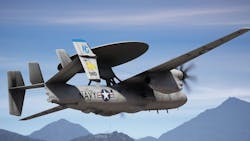Lockheed Martin to upgrade the electronic warfare and SIGINT avionics in Navy E-2D surveillance aircraft
PATUXENT RIVER NAS, Md. – Avionics experts at Lockheed Martin Corp. will upgrade electronic warfare (EW) systems aboard the U.S. Navy E-2D Advanced Hawkeye carrier-based airborne early warning aircraft under terms of a $30.6 million order.
Lockheed Martin is upgrading the advanced digital receiver and processor (ADRP) in the U.S. Navy E-2D’s AN/ALQ-217 electronic support measures (ESM) receiver and processor systems.
Officials of the Naval Air Systems Command at Patuxent River Naval Air Station, Md., are asking the Lockheed Martin Rotary and Mission Systems segment in Owego, N.Y., also to integrate the ADRP avionics with the E-2D's mission computer and display system as a form, fit, function replacement for the Advanced Hawkeye aircraft.
Electronic support measures represent one branch of EW that detects, intercepts, identifies, locates, records, and analyzes radio signals for threat recognition and EW planning.
Electronic Support data can support signals intelligence (SIGINT), communications intelligence (COMINT) and electronics intelligence (ELINT) by passive listening to electromagnetic radiations of military interest.
The Navy Northrop Grumman E-2D is a tactical airborne early warning (AEW) aircraft designed to operate from aircraft carriers. The twin-engine turboprop aircraft has a distinctive saucer-like antenna, and provides the carrier battle group with wide-area radar surveillance for enemy monitoring and combat air traffic control.
The Lockheed Martin AN/ALQ-217 ESM system functions as the ears of the E-2D and other advanced tactical aircraft. As a passive sensor system, the AN/ALQ-217 identifies and locates sources of radio frequency (RF) emission.
The AN/ALQ-217 uses an open-systems architecture and commercial off-the-shelf (COTS) processing. The system has four antennas, four active front ends, and a combined receiver and processor.
Related: Military re-learns the importance of electronic warfare (EW)
The AN/ALQ-217 is designed to perform in dense littoral and open-ocean environments; has adaptable system performance; has tailorable hardware and software to new platforms; and fast reaction time, Lockheed Martin officials say.
The system provides fast angle of arrival information and weapon system identification; identifies the type, function, and mode of the intercepted emitters; and can pinpoint emitter position quickly.
On this order Lockheed Martin will do the work in Owego, N.Y., and should be finished by September 2024. For more information contact Lockheed Martin Rotary and Mission Systems online at www.lockheedmartin.com/en-us/who-we-are/business-areas/rotary-and-mission-systems.html, or Naval Air Systems Command at www.navair.navy.mil.
About the Author
John Keller
Editor-in-Chief
John Keller is the Editor-in-Chief, Military & Aerospace Electronics Magazine--provides extensive coverage and analysis of enabling electronics and optoelectronic technologies in military, space and commercial aviation applications. John has been a member of the Military & Aerospace Electronics staff since 1989 and chief editor since 1995.
